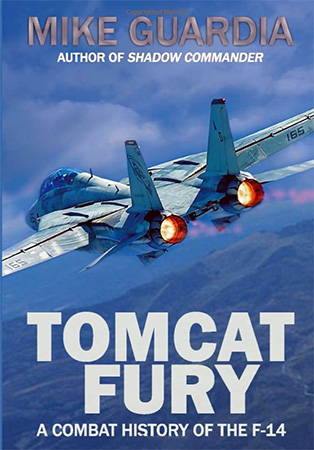
Tomcat Fury Book Review
By Michael Benolkin
| Date of Review | November 2019 | Title | Tomcat Fury |
|---|---|---|---|
| Author | Mike Guardia | Publisher | Magnum Books |
| Published | 2019 | ISBN | 978-0999644331 |
| Format | 154 pages, softbound | MSRP (USD) | $29.95 |
Review
If you're as much of a fan of the F-14 Tomcat as I am, you no-doubt have a variety of references on your shelf, but few provide the first-hand perspective of the aircrews in combat as the latest title from author Mike Guardia, who tells the stories of key combat events in the F-14 Tomcat's history. There are few good Tomcat books out there that are produced by a good storyteller.
The author provides a good starting point with how the Tomcat was developed from the failed attempt by the Secretary of Defense Robert McNamara to force the Navy to fly the same aircraft as the U.S. Air Force - the F-111. The F-111B was the Navy's version of the TFX procurement, but it weighed in at more than five tons heavier than the Navy's heaviest carrier-based aircraft - the A-3 Skywarrior. During carrier evaluations, some swore that the 'nautical vark' left dents on the aft flight deck when the aircraft trapped aboard the boat. Once common sense prevailed, the F-111B was cancelled, but many of the expensive parts (including the TF30 engines, AWG-9 radar system, and the AIM-54 Phoenix) were incorporated into Grumman's solution - the F-14 Tomcat.
The title picks up key combat events throughout the Tomcat's career, including first-blood over the Gulf of Sidra in 1981, reconnaissance and deterrence actions in various theaters around the globe, Gulf of Sidra round 2 in 1989, and combat operations during Enduring Freedom and Iraqi Freedom, including the ejection, capture, and eventual release of one Tomcat crewman lost behind enemy lines.
In addition to the great insights and experiences that are described in each of the chapters covering the Tomcat's career with the U.S. Navy, there is also nice coverage of the Tomcat's service in Iran. Originally sold by the Nixon administration to the Imperial Iranian Air Force, the Shah wanted to force a halt to the regular overflight of reconnaissance MiG-25s over his country and the F-14 was the only aircraft capable of reaching the high-altitude, Mach 2.8 speed demon. By some coincidence, as soon as the F-14s became operational, the MiG-25 overflights suddenly stopped. With the revolution in Iran that established the Islamic Republic, the F-14s were eventually pressed into service and would become the only Tomcats to ever use the AIM-54 in anger against the Iraqi Air Force. You'll find first-hand perspectives in these stories as well.
One minor point, the Tomcat's gun isn't an autocannon. The M61 Vulcan 20mm gun is technically a Gatling gun. But I digress...
There are a variety of books on the F-14 Tomcat, and while good technical/detail references are welcome, there's nothing like kicking back and reading some good action-packed books. A few books have even provided detailed after-action analyses of the Tomcat in combat, which again are handy, but reading such actions from the point of view of the crew is entertaining while remaining true to the events. This is one of of those titles that you'll pick up and won't be able to put down until the last aircraft is safely back on deck.
My sincere thanks to Mike Guardia for this review copy!







